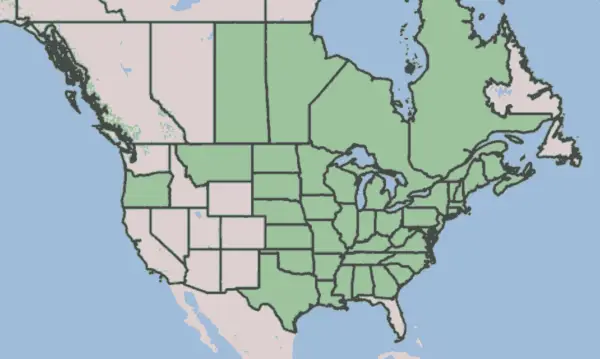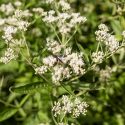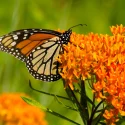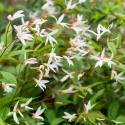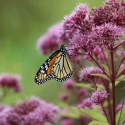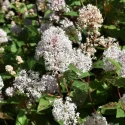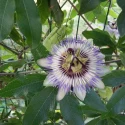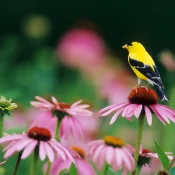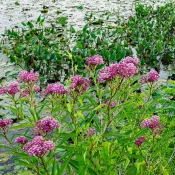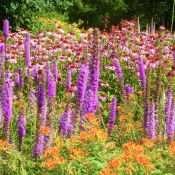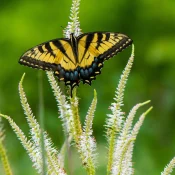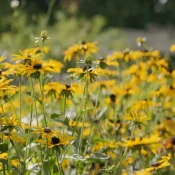Common Milkweed—this blah name hides its power. This is one tough flower. Drought, full sun, diesel exhaust on highways—this plant can take it all. Most importantly: Common Milkweed is a host plant for the Monarch butterfly. Common Milkweed can be planted in most of the continental United States and most of Canada, too. If you have a spot for this tall powerhouse, plant 5+ immediately to help the Monarchs. Scroll on for planting tips.
Meet Common Milkweed
Common milkweed is a North American native perennial known for its clusters of pink to lavender-colored flowers that bloom in midsummer. Its botanical name, Asclepias syriaca, pays homage to Asclepius, the Greek god of healing, emphasizing the plant’s historical medicinal uses.

How to grow Common Milkweed
Sunlight: Common milkweed thrives in full sunlight. Ensure your garden bed receives at least 6-8 hours of direct sunlight each day.
Soil: Well-draining soil is crucial for the success of common milkweed. It is adaptable to various soil types but prefers slightly sandy or loamy soil. Adding organic matter can improve soil structure.
Watering: While common milkweed is drought-tolerant, it benefits from consistent watering, especially during dry spells. Water the plant at the base to avoid wetting the leaves, as this can help prevent diseases.
Where is Common Milkweed native?
Common Milkweed is native to most of North America. It is one of the most ubiquitous milkweeds (there are approximately 100 different milkweed species in total.)
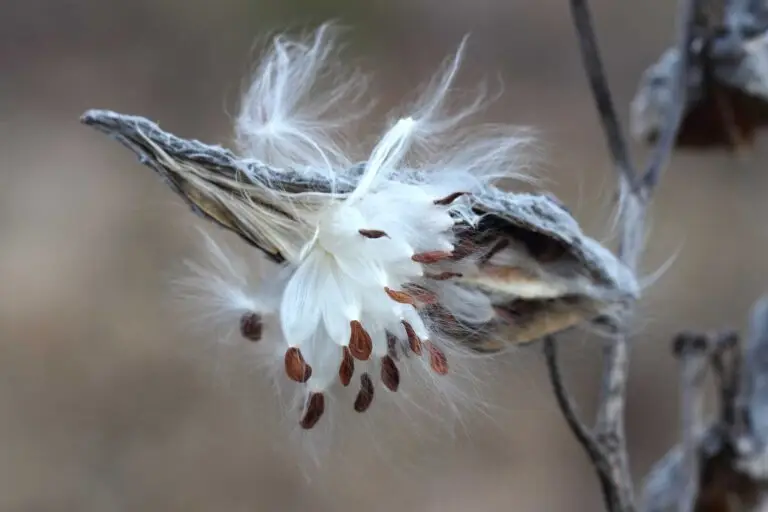
How can I plant Common Milkweed by seed?
Common Milkweed is easy to plant from seed in either the fall or the spring. It may take two years to see flowers if you plant this way: the first year, the Common Milkweed is focused on growing roots.
800-mile tip for seeds and planting
A big tip for picking seeds is to try to buy or obtain seeds from places that are within 800 miles (or less!) of where you live—the closer, the better. This ensures that the seeds you’re buying are suited for your area (Common Milkweed seeds from Iowa might not be the best seeds for a garden in New York.)
Provenance matters for seeds and plants
Where a seed comes from—its provenance—matters. It ensures that the DNA of your Common Milkweed mixes well with the genomes in your area. Not to get too nerdy… but to ensure that our gardens positively contribute to biodiversity (making plants more resilient and helpful to wildlife), staying within a 800-mile radius is our best bet.
Plants and seeds grown close to home are tuned to your soil, weather, and pollinators. Stay within 500 miles—or about a day’s drive—to help your garden thrive naturally.
Common Milkweed seed sellers
Here are some online seed sellers (alongside their locations) that sell Common Milkweed seeds:
- Elk Mound Seed (Elk Mound, Wisconsin)
- Mid-Atlantic Natives (Cobbs Creek, Virginia)
- Prairie Nursery (Westfield, Wisconsin)
- Select Seeds (Union, Connecticut)
What are good pairings for Common Milkweed?
Pair this sun-loving native flower with friends who like the same full sun, well drained environment. Great pairings include:
Common Milkweed is deer-proof
Deer do NOT eat Common Milkweed. If you’re worried about deer nibbling your garden, planting Common Milkweed is a good native gardening choice.
And that sums up our love letter to native favorite Common Milkweed! This beautiful flower is one of 100 different species of milkweed—read our Beginner’s Guide to Milkweed to meet others. All milkweed species are host plants for the Monarch butterfly. Planting milkweed ensures that we have beautiful, easy-to-care-for landscapes that support our beloved, iconic wildlife. Common Milkweed has been overlooked for its beauty and resiliency—let’s turn that trend around! Plant them via seeds or pick up some plants from your local nursery, and be on the lookout for Monarch caterpillars in the fall. Happy planting!
Sources
- Nelson, Gil. Best Native Plants for Southern Gardens: A Handbook for Gardeners, Homeowners, and Professionals, (2010).
- Harstad, Carolyn. Go Native! Gardening with Native Plants and Wildflowers in the Lower Midwest. (1999), 209-210.
What if your feed was actually good for your mental health?
Give your algorithm a breath of fresh air and follow us.

